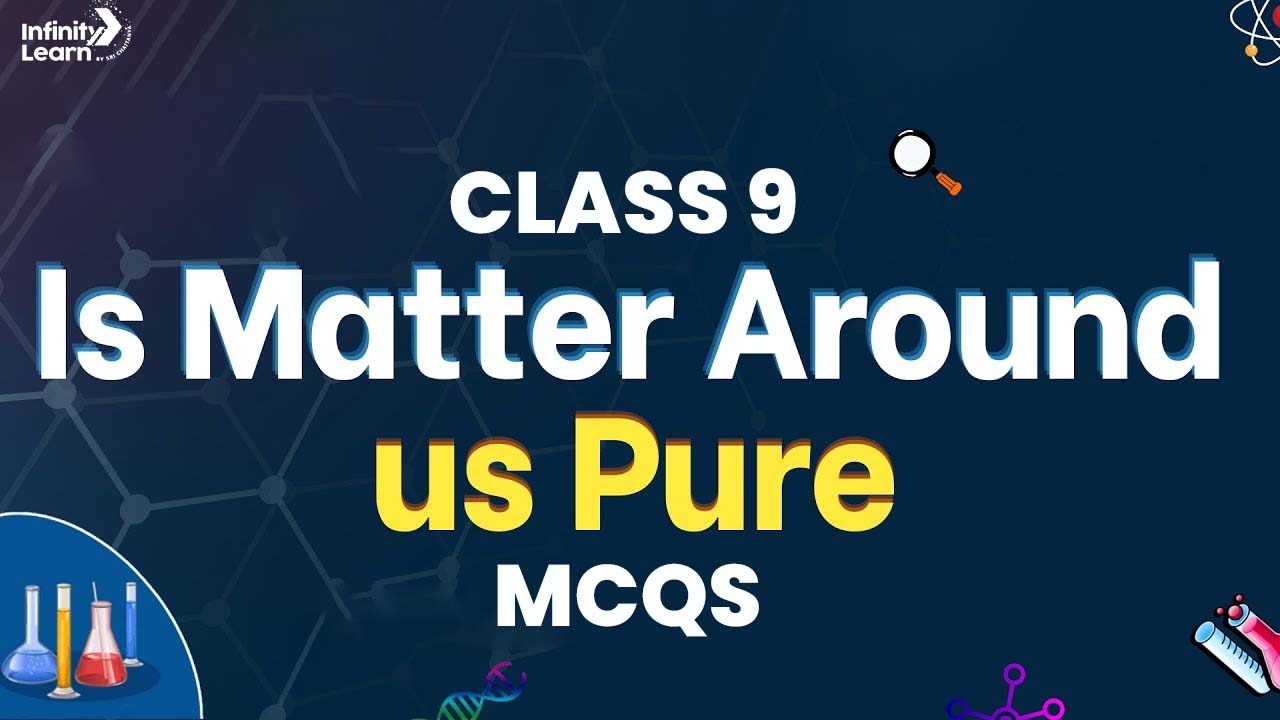Table of Contents
Is Matter Around Us Pure MCQ: Access the most Important MCQs on Class 9 Science Chapter 3 “Is Matter Around Us Pure” to help in your preparation for the upcoming Science Annual Examination.
Below are multiple-choice questions (MCQs) along with answers for Chapter 2: “Is Matter Around Us Pure?” from the CBSE board curriculum for Class 9 chemistry. These questions are designed to help students review the chapter quickly and prepare for their Class 9 annual examinations. They are also beneficial for other entrance exams such as CTET and KVS. By practicing these Class 9 MCQs, students can grasp the key concepts covered in the chapter more effectively.
Class 9 Science MCQs – Chapter-wise
- Matter in Our Surroundings
- Is Matter Around Us Pure
- Atoms and Molecules
- Structure of Atom
- The Fundamental Unit of Life

Is Matter Around Us Pure – Introduction
This chapter explores the concept of purity in matter, diving into what it means for something to be pure and the various forms it can take
- Definition of Pure Substances: Understand what constitutes a pure substance and how it differs from mixtures.
- Types of Pure Substances: Learn about elements and compounds as examples of pure substances and how they are distinct from each other.
- Characteristics of Pure Substances: Explore the physical and chemical properties that define pure substances, such as melting point, boiling point, density, and reactivity.
- Methods of Purification: Discover various techniques used to purify substances, including distillation, filtration, chromatography, and crystallization.
- Impurities and their Effects: Understand how impurities affect the properties and behavior of substances, and why purity is essential in many scientific and industrial processes.
- Purity Analysis: Learn about methods for assessing the purity of substances, such as titration, spectroscopy, and analytical chemistry techniques.
- Applications and Importance: Explore the significance of purity in industries like pharmaceuticals, electronics, food production, and environmental science.
Also Check other Resources for Class 9 Science Chapter 2
- Extra Questions Class 9 Science Chapter 2 Is Matter Around Us Pure
- NCERT Exemplar Class 9 Science Solutions Chapter 2 – Is Matter Around Us Pure
Is Matter Around Us Pure MCQ Class 9 (Easy to Moderate Level)
Practice these Is Matter Around Us Pure MCQ to deepen your understanding of the concept.
1. Which of the following is a homogeneous mixture?
A) Saltwater
B) Sand and iron filings
C) Oil and water
D) Milk and water
Answer: A) Saltwater
2. The process of separating a mixture of liquids with different boiling points is called?
A) Filtration
B) Evaporation
C) Distillation
D) Condensation
Answer: C) Distillation
3. Which of the following is a pure substance?
A) Air
B) Sugar solution
C) Salt solution
D) Gold
Answer: D) Gold
Also Check: NCERT Book Class 9 Science
4. The process of conversion of a solid directly into gas without passing through the liquid state is called?
A) Melting
B) Evaporation
C) Sublimation
D) Condensation
Answer: C) Sublimation
5. A solution that cannot dissolve any more solute at a given temperature is said to be?
A) Unsaturated
B) Saturated
C) Supersaturated
D) Dilute
Answer: B) Saturated
Class 9 HOTS Course
The Class 9 HOTS Course enhances critical thinking and problem-solving skills through engaging activities and advanced learning techniques, ensuring academic excellence.
| Class 9 Important Links | Easy to Most Difficult subjects in Class 9 | How To Score Full Marks In CBSE Class 9 Science Exam | Important Diagrams For CBSE Class 9 Science | Top 10 Science Project Ideas For Class 9 | |
6. Which method is used to separate a mixture of salt and water?
A) Filtration
B) Evaporation
C) Decantation
D) Sublimation
Answer: B) Evaporation
7. Which of the following is not a physical change?
A) Boiling of water
B) Rusting of iron
C) Freezing of water
D) Melting of wax
Answer: B) Rusting of iron
8. The smallest particle of an element that retains all the properties of that element is called a(n):
A) Atom
B) Molecule
C) Compound
D) Ion
Answer: A) Atom
- CBSE Worksheets for Class 9 Biology
- CBSE Worksheets for Class 9 Chemistry
- CBSE Worksheets for Class 9 Physics
Class 9 Is Matter Around Us Pure MCQ (Moderate to High Level)
1. Which of the following statements accurately describe pure substances?
I. Pure substances consist of only one type of particles.
II. Pure substances can be compounds or mixtures.
III. Pure substances maintain a consistent composition throughout.
IV. Pure substances are exemplified by all elements except nickel.
A) I and II
B) I and III
C) III and IV
D) II and III
Answer: B- I and III
2. Two substances, A and B, react to form a third substance, A2B, according to the following reaction: 2A + B → A2B
Which of the following statements concerning this reaction are incorrect?
I. The product A2B shows the properties of substances A and B.
II. The product will always have a fixed composition.
III. The product so formed cannot be classified as a compound.
IV. The product so formed is an element.
A) I and III
B) II and IV
C) III and IV
D) I and II
Answer: C) III and IV
3. Two chemical species X and Y combine together to form a product P which contains both X and Y, X + Y → P. X and Y cannot be broken down into simpler substances by simple chemical reactions. Which of the following concerning the species X, Y, and P are correct?
I. P is a compound.
II. X and Y are compounds.
III. X and Y are elements.
IV. P has a fixed composition.
A) I and III
B) II and IV
C) III and IV
D) I and II
Answer: B) II and IV
Also Check: NCERT Solutions Class 9 Science
Is Matter Around Us Pure MCQ Class 9 with Answers
1. Which of the following is an example of a heterogeneous mixture?
A) Saltwater
B) Air
C) Granite
D) Lemonade
Answer: C) Granite
2. Which of the following methods can be used to separate the components of a mixture of salt and water?
A) Filtration
B) Distillation
C) Evaporation
D) Chromatography
Answer: C) Evaporation
3. Which of the following statements about solutions is true?
A) Solutions are always homogeneous mixtures.
B) Solutions can be separated into their components by filtration.
C) The solute is present in larger quantity than the solvent in a solution.
D) Solutions cannot be formed with gases.
Answer: A) Solutions are always homogeneous mixtures.
Also Check: Worksheets Class 9 Chemistry
4. Which of the following is a chemical change?
A) Freezing water to form ice
B) Cutting a piece of wood into smaller pieces
C) Digesting food in the stomach
D) Melting chocolate to form a liquid
Answer: C) Digesting food in the stomach
5. In a process where a liquid is rapidly rotated, denser particles settle at the bottom while lighter particles remain at the top. This principle finds application in:
(a) Centrifugation
(b) Fractional distillation
(c) Evaporation
(d) Tunneling
Answer: (a) Centrifugation








